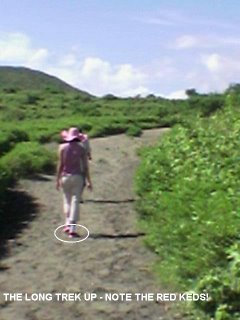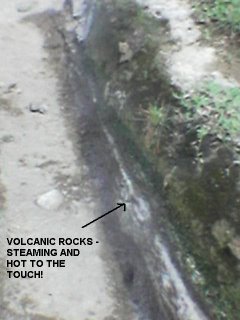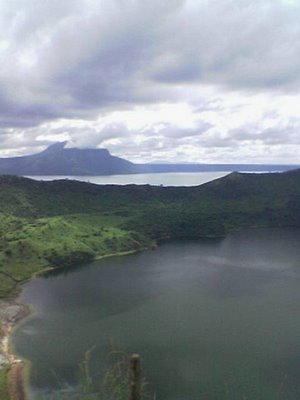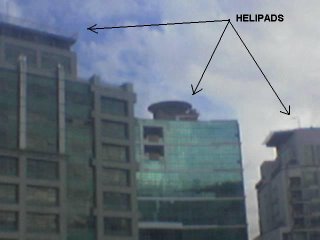Because it’s there.
- George Leigh Mallory, in a March 1923 interview with The New York Times, when asked why he wanted to climb Mount Everest. Mallory and his fellow climber, Andrew Irvine, were lost on Everest the following year. His body was found 75 years later, in 1999.
Having surveyed the volcano and gotten a lay of the land over spoonfuls of Halo-Halo and Putabumboong, we spent the past several weeks carefully planning our ascent. The details had to be meticulously ironed out as, due to our shoestring budget and general inability to climb anything higher than a flight of stairs, we could make one, and only one, summit attempt that day.
An analysis of weather patterns and in-depth interviews with successful climbers - plus the insistence of a visiting friend who was leaving for India the following day - led us to choose Sunday, 30th October as the best day for the effort. We anticipated the sun to shine through the first half of the day, making it imperative for us to make it back down before lunch or risk being stranded on the summit when the rain came down, transforming the slopes into a morass of mud that could engulf my new Sprandi sneakers in a matter of minutes.
Planning the Ascent
Getting to the top is optional, but getting down is mandatory
- Ed Viesturs, member of ill-fated 1996 Everest expedition
We were flirting with danger and we knew it. After all, the summit is only the halfway point - we had to make it back down. Our scant resources did not offer us much comfort either. One of our sponsors had backed out at the last minute, electing to fund an India-Pakistan cricket series instead. Under these conditions, it was suicide to even make the attempt.
We had decided to travel light, so Sandi selected a variety of energy-packed foods and drinks (sweet and / or fattening) that would sustain us on the long, hard climb to the top (and for several days afterwards, as the weight on my back would later testify). This, in hindsight, was a costly mistake, as we essentially ended up carrying about half our body weight in cans and bottles, a light little parcel if you are an ant but a dead weight if you are a human being. We would eventually have to jettison much of what we had carried in the car itself, even before we started the arduous climb.
Sandi, as base camp manager, handled the logistics. We were able to hire a car from Avis at a special promotional day rate of 1,700 pesos and borrow a friend’s driver for another 500. Provisions came to about 500 or so. Based on the extensive experience we had of such expeditions in the past, we knew the critical items of equipment were caps, thick socks, comfortable walking shoes and our trusty backpacks. So while I got out my trusty Sprandi sneakers, Sandi rustled up a pair of little red keds that would have made Reese Witherspoon look like the Terminator by contrast. That was mistake number two.
We also did not take cognizance of the weather, which was extremely pleasant and agreeable that morning, an ominous omen on a trip like this and indicating pain and torture every step of the way. But we pushed on, heedless, caught helplessly in ‘summit fever’.
We're Off!
We reached the foothills – or rather the foot lake - of the volcano early in the morning and were immediately faced with our first major challenge. How do we avoid getting conned by the masses of boatmen who were thronging outside our car, outdoing themselves in quoting ridiculous fares – 2000, 3000, 5000… it was like an auction!
And then Sandi, in her first heroic action of the day, cried out, “One thousand”.
[The second was in persisting with the keds]
The boatmen went still. Hushed murmurs went all around, as people whispered to their neighbours, “One thousand, one thousand”.
One thousand. It had never been done before. Was it possible? Could it be…?
Finally, after what seemed an eternity, one man stepped forward, gazing thoughtfully at our little threesome (Sandi, me and our friend), ‘I will do it, ma’am.’ The respect simply shone from his eyes as he ushered us to our boat.
And we were off!
At the Volcano
The little boat sped across the water while we marveled at the large, looming mass of cinders, ash and igneous rock that loomed up in front of us – the Taal volcano. It could have been heavenly, the boat gently swaying, the soft swoosh of the waves as they crested on the sides, the clean, fresh-smelling breeze... Only it wasn’t thanks to the loud, foul-smelling drone of the outboard motor that made conversation impossible until you almost wished the volcano would erupt, if only to wipe out the engine from the face of the earth.
Perhaps 15 minutes later, temporarily deafened, we landed at the base of the volcano and prepared for the climb. We had stashed the heavier tins and bottles back in the car (Base Camp), where other climbers could use them in the future, in case we didn’t return. The remainder we distributed between the three of us.
We decided upon the services of a local sherpa (actually a Filipino, but it sounds so much better that way), who promised to guide us safely through the supposed multitude of false paths and dead ends that had claimed the lives of many, or so he gave us to understand. In return he demanded 500, settling finally for 200.
This, as it turned out, was our third mistake, because he ended up having a leisurely 200-peso stroll up the hillside while we huffed and puffed ourselves silly along the one and only path that you could take up the mountain unless, of course, you are a mountain goat or somewhat addled in the head.
The Ascent
I climbed Everest so that my children wouldn’t have to.
- Jamling Tenzing Norgay, son of Tenzing Norgay
 The Taal volcano towers a majestic 1300 feet above sea level, and can take even an experienced walker upwards of forty-five minutes to climb. Its single path is treacherous, leading off into side trails that could make you wander alone and disoriented for as far as ten feet before rejoining the main path. And if that were not enough, you have to make your way through dozens of wild, snorting, foaming horses carrying unimaginably obese American tourists, whose hooves (the horses’, not the tourists’) can set off avalanches of pebbles that really smart when they hit your shin.
The Taal volcano towers a majestic 1300 feet above sea level, and can take even an experienced walker upwards of forty-five minutes to climb. Its single path is treacherous, leading off into side trails that could make you wander alone and disoriented for as far as ten feet before rejoining the main path. And if that were not enough, you have to make your way through dozens of wild, snorting, foaming horses carrying unimaginably obese American tourists, whose hooves (the horses’, not the tourists’) can set off avalanches of pebbles that really smart when they hit your shin.
And there we were, three misguided climbers, trying to make our way with the best of them!
 The ascent may be divided by contour lines into three parts - an initial 100 vertical feet where you stride gaily, laughing and singing old Hindi marching songs (Kadam Kadam Badhaye Ja is a favourite), followed by 1100 feet of agony after your lungs have collapsed under the strain and you’ve discovered that red keds are best left in the nursery. These 1100 feet also feature some uncomfortably hot, steaming rocks along the way.
The ascent may be divided by contour lines into three parts - an initial 100 vertical feet where you stride gaily, laughing and singing old Hindi marching songs (Kadam Kadam Badhaye Ja is a favourite), followed by 1100 feet of agony after your lungs have collapsed under the strain and you’ve discovered that red keds are best left in the nursery. These 1100 feet also feature some uncomfortably hot, steaming rocks along the way.
The final 100 feet is called the Death Zone as a combination of high altitude and torn ligaments leaves you light-headed and unable to think clearly. Decision-making is a strain and all entreaties to get up and cover the final 100 yards are met with blank incomprehension. There is little that your teammates can do but struggle on and leave you or it is likely they will meet the same fate. It is survival of the fittest - a cruel, but well understood code of the mountains.
After the initial 100 feet, we established our first camp (Camp 1) and stopped for a drink of bottled carbon dioxide, though we desperately wished we'd carried bottled oxygen instead.
We made slow, but certain progress, establishing a series of camps along the way until, finally, we reached the Death Zone immediately after Camp 21 (or maybe it was 31), where we began to really feel the effects of about two litres of bottled carbon dioxide sloshing about inside us. It seemed rather insistent on getting out. Perhaps it was the low pressure around.
And it was here we had our first casualty when our friend, who’d so far struggled gamely against the effects of about a decade of sedentary life, collapsed gasping to the ground and said “Leave me. Save yourselves” or something thereabouts.
We vowed not to forget him, a promise we made good on several years later when we reached the top and arranged for the guide to go down and help him up the last 15 feet.
Having overcome the debilitating effects of the Death Zone, we feasted our weary eyes on the delights at the top – a police post, a ramshackle toilet and a coconut seller.
Thankfully, on shuffling a few steps further, we caught sight of the lake nestling in the middle of the volcano and it was all really worth it.
We spent about half an hour on the summit, drinking heartily of some really sweet coconut water, before making a half-hearted attempt at using the loo - none of us got any closer than 5 feet of the stinking mess - and starting on our way down where we relieved ourselves like horses (and a mare) behind various bushes on the way. Now we know why there are so many little paths leading off into nowhere.
We slid the last 500 feet or so before finally arriving miles away from our boat and having to walk half-way across the island before finding it. Sandi's little keds were by now glistening redder than ever and she had to be stuffed into our backpacks for the last few metres.
[I wanted to post some more snaps but am having trouble posting the remaining pictures. I hope I'll be able to include them some time later.]












